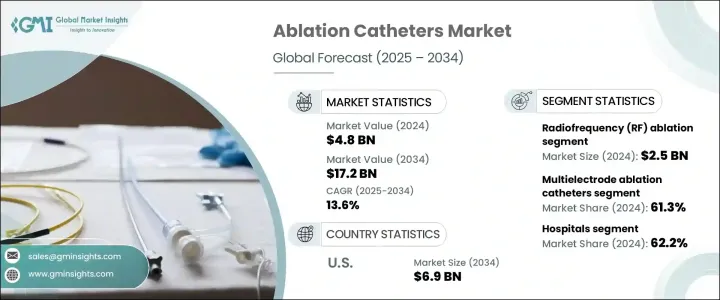
세계의 절제 카테터 시장은 2024년에는 48억 달러로 평가되었고 전 세계적으로 심방 세동(AFib) 및 기타 부정맥의 유병률이 증가함에 따라 2034년에는 172억 달러에 이를 것으로 예측되며 CAGR 13.6%로 성장할 전망입니다.
카테터 설계 기술의 발전, 특히 팁 설계 개선, 접촉력 기술, 냉동 절제술과 펄스 필드 절제술과 같은 새로운 에너지 모달리티의 도입은 이러한 시술의 정밀도와 안전성을 향상시키고 있습니다. 이러한 혁신은 절제 카테터의 임상적 적용 범위를 확장했을 뿐만 아니라 의료진의 신뢰도를 높여 다양한 의료 환경에서 채택이 증가하고 있습니다.

절제 카테터는 부정맥(불규칙한 심장 박동)을 치료하기 위해 현대 심장 치료에서 필수적인 도구입니다. 이 카테터는 심장 조직의 특정 부위에 이상적인 전기 신호를 유발하는 부위에 표적화된 에너지를 전달하여 작동합니다. 사용되는 에너지 유형에 따라 이 카테터는 라디오주파수(RF) 에너지, 냉동 에너지, 또는 펄스 전기장을 적용하여 심장 조직에 통제된 손상을 유발해 결함 있는 전기 경로를 차단하거나 수정합니다. 이 조직의 표적 파괴는 정상적인 심장 리듬을 회복시켜 환자에게 장기적인 약물 치료나 더 침습적인 수술 절차의 대안을 제공합니다. 라디오주파수 절제술은 가장 널리 사용되는 방법으로, 심장 조직에 열을 가해 병변을 생성하여 이상적인 전기 신호를 차단하거나 수정합니다.
| 시장 범위 | |
|---|---|
| 시작 연도 | 2024년 |
| 예측 연도 | 2025-2034년 |
| 시작 금액 | 48억 달러 |
| 예측 금액 | 172억 달러 |
| CAGR | 13.6% |
시장은 다중 전극 및 단일 점 절제 카테터로 구분됩니다. 다중 전극 부문은 2024년에 61.3%의 점유율로 우위를 차지했습니다. 이 부문은 특히 AFib의 발병률 증가와 동시에 매핑 및 치료가 가능한 카테터에 대한 수요 증가로 인해 수요가 증가하고 있습니다. 다중 전극 카테터는 시술 시간 단축, 마취 요구 사항 감소, 임상 결과 개선 등 여러 가지 장점을 제공하기 때문에 대량 전기 생리학 연구소에서 매력적인 옵션으로 자리 잡고 있습니다.
미국의 절제 카테터 시장은 2024년에 20억 달러의 매출을 올렸으며, 이는 주로 인구 고령화와 고혈압, 당뇨병 등 생활 습관 관련 위험 요인으로 인한 심방 세동 등 심혈관 질환의 발병률 증가에 의해 촉진되었습니다. 환자 수가 증가함에 따라 카테터 기반 절제 시술에 대한 수요가 증가했으며, 심장 리듬 장애 치료에 대한 보험 환급 정책 및 의료 시스템의 지원이 이러한 추세를 더욱 부추겼습니다.
절제 카테터 시장 주요 기업에는 Abbott Laboratories, AngioDynamics, AtriCure, Biotronik, Boston Scientific, Medtronic 등이 있습니다. 이들 기업은 기술 혁신을 통해 더 안전하고 효과적인 기기 개발을 위해 지속적으로 노력하고 있습니다. 주요 기업들이 채택한 전략에는 지속적인 기술 혁신, 전략적 파트너십, 제품 포트폴리오 확장 등이 포함됩니다. Boston Scientific과 Medtronic과 같은 기업들은 접촉력 감지 및 온도 조절 에너지 전달과 같은 고급 기능을 통합하여 카테터 효율성을 향상시키는 데 집중하고 있습니다. 이러한 혁신은 절차 결과 개선과 환자 안전 강화에 목적을 두고 있습니다.
The Global Ablation Catheters Market was valued at USD 4.8 billion in 2024 and is estimated to grow at a CAGR of 13.6% to reach USD 17.2 billion by 2034, driven by the increasing prevalence of atrial fibrillation (AFib) and other arrhythmias worldwide. Technological advancements in catheter design, including improvements in tip design, contact force technology, and new energy modalities like cryoablation and pulsed field ablation, are enhancing the precision and safety of these procedures. These innovations have not only expanded the clinical applications of ablation catheters but also boosted physician confidence, resulting in greater adoption across various healthcare settings.

Ablation catheters are vital instruments in modern cardiac care, specifically designed to treat arrhythmias, which are irregular heartbeats. These catheters work by delivering targeted energy to specific areas of the heart tissue that are causing abnormal electrical signals. Depending on the type of energy used, these catheters can apply radiofrequency (RF) energy, cryothermal energy, or pulsed electric fields to create controlled lesions in the heart tissue, effectively disrupting the faulty electrical pathways. This targeted destruction of tissue helps restore a normal heart rhythm, offering patients an alternative to long-term medication or more invasive surgical procedures. Radiofrequency ablation is the most used method, where heat is applied to the heart tissue, creating lesions that block or modify abnormal electrical signals.
| Market Scope | |
|---|---|
| Start Year | 2024 |
| Forecast Year | 2025-2034 |
| Start Value | $4.8 Billion |
| Forecast Value | $17.2 Billion |
| CAGR | 13.6% |
The market is divided into multielectrode and single-point ablation catheters. The multielectrode segment dominated in 2024, holding a 61.3% share. This segment is seeing increased demand, particularly due to the rising incidence of AFib and the need for catheters that can map and treat simultaneously. Multielectrode catheters offer several advantages, including faster procedural times, reduced anesthesia requirements, and improved clinical outcomes, making them an attractive option in high-volume electrophysiology labs.
In terms of technology, radiofrequency (RF) ablation remains the dominant method, contributing USD 2.5 billion in 2024. RF ablation is widely regarded as the gold standard in cardiac rhythm management due to its reliability, safety, and ability to produce permanent lesions in the heart. RF ablation catheters also benefit from advancements such as temperature-controlled energy delivery, irrigated tips, and contact force sensing, which improve both safety and efficacy during procedures.
United States Ablation Catheters Market generated USD 2 billion in 2024, driven by the increasing incidence of cardiovascular diseases, including AFib, largely due to an aging population and lifestyle-related risk factors such as hypertension and diabetes. This growing patient pool has led to higher demand for catheter-based ablation procedures, further fueled by favorable insurance reimbursement policies and healthcare system support for arrhythmia treatments.
The leading companies in the ablation catheters market include Abbott Laboratories, AngioDynamics, AtriCure, Biotronik, Boston Scientific, and Medtronic. These companies continue to innovate, pushing the boundaries of technology to develop safer and more effective devices. Key strategies adopted by major companies in the ablation catheters market include continuous technological innovation, strategic partnerships, and expanding their product portfolios. Companies like Boston Scientific and Medtronic are focused on improving catheter efficiency by integrating advanced features such as contact force sensing and temperature-controlled energy delivery. These innovations aim to enhance procedural outcomes and patient safety.